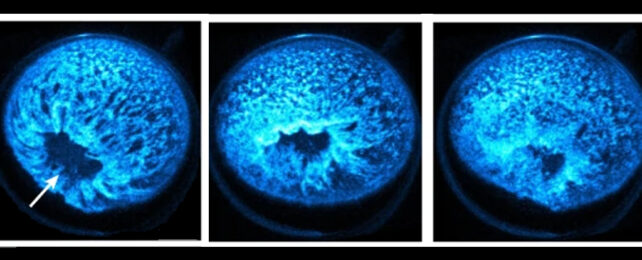A dazzling rearrangement of egg cell innards follows fertilization, but until now we didn't know how. New research reveals friction helps shape the cell to create a centralized point of organization, at least in ascidians… animals better known as sea squirts.
Like a potter's hand moulding spinning clay, the gentle rubbing between a cell's components is enough to guide and shape the formation of an important piece of its anatomy.
Referred to as the contraction pole, this organization point is critical for telling the sea squirt egg cells (oocytes) where to put its nucleus, the machinery it needs for cell division, and other cellular organelles.
So Austria's Institute of Science and Technology (ISTA) biophysicist Silvia Caballero-Mancebo and colleagues took a close look at this process. They highlighted and imaged different components of the ascidian oocytes to expose their roles.
"While ascidians exhibit the basic developmental and morphological features of vertebrates, they also have the cellular and genomic simplicity typical of invertebrates," explains ISTA biophysicist Carl-Philipp Heisenberg. "Especially the ascidian larva is an ideal model for understanding early vertebrate development."
The researchers found that on fertilization a gradient forms across the cell causing the actin (stained green in the video below) in the outer layer – or cortex – to flow and rub against the more stationary layer – or myoplasm (stained blue) – within. The resulting friction squishes the cell into an oval shape, and causes the cortex to form a bump.
At this point the actin stops flowing, releasing the hug of friction.
During the squish, points of the myoplasm also buckle. Once the tension is released the oocyte bounces back into a more rounded blob, with the weak points sliding into the cortex's bulge to create a single, larger lump.
This newly-formed mound in the otherwise round oocyte is that all important contraction pole. It's within this space the cell stores resources like mRNA from the mother, which will soon be used for embryo patterning.
"Taken together, our data show that ooplasmic reorganization and contraction pole formation in ascidian oocytes depend on the combined activities of the actomyosin cortex and the mitochondria-rich myoplasm through friction forces arising at their interface," the team concludes in their paper.
The whole process takes a mere 14 minutes.
While still very early on in our understanding, Caballero-Mancebo and colleagues have demonstrated the vital role friction can play in helping form developing life.
This research was published in Nature Physics.
